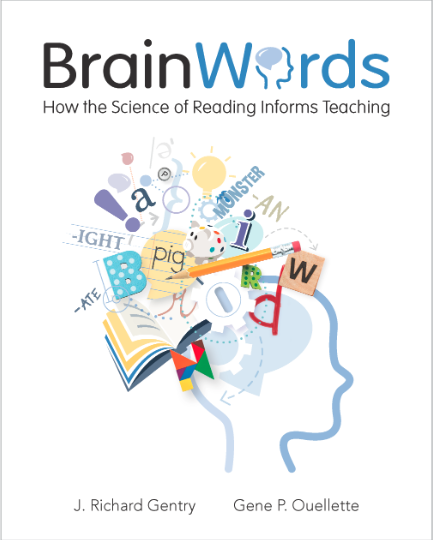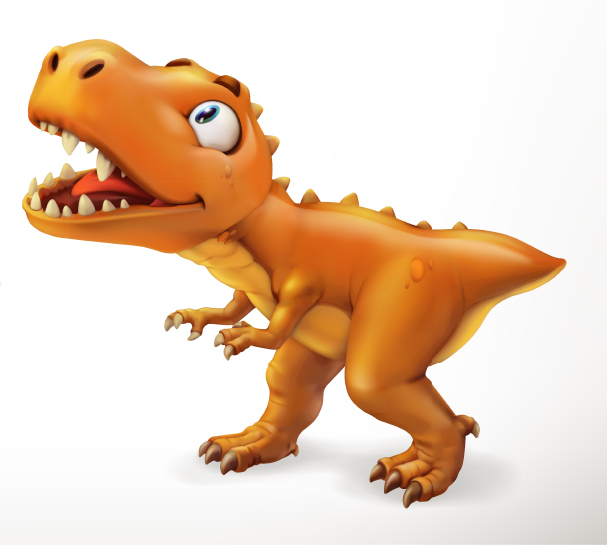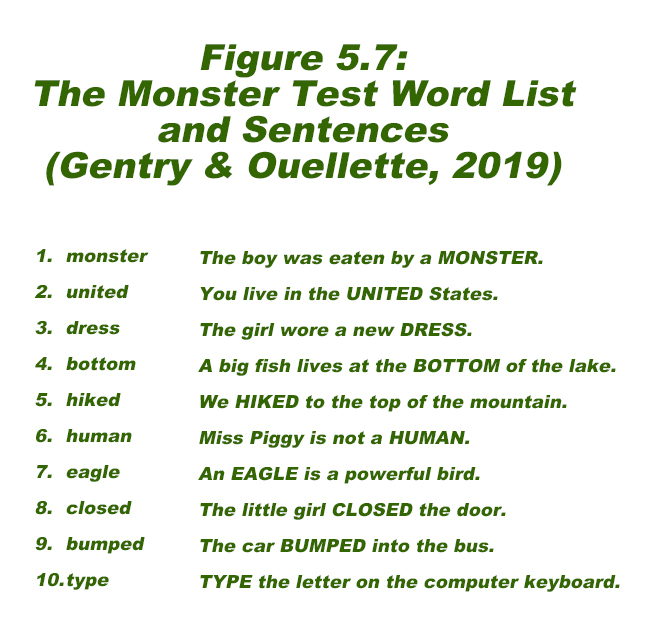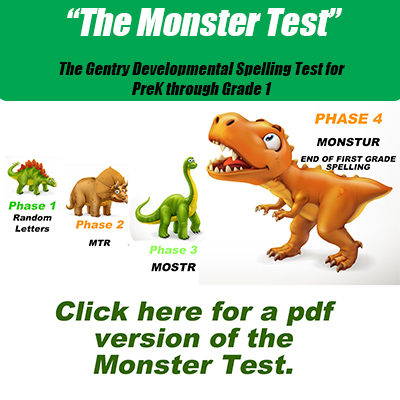Faster Steps to Your Goal
The Monster Test
Gentry Developmental Spelling Test
for PreK through Grade 1

Taken From Brain Words
Easy Early Assessment with the Monster Test
“Gentry’s Monster Test of developmental spelling (1985), newly supported by what we know from cognitive psychology and neuroscience, has been in use for over thirty years. It’s a ten-item test with words selected based on research-derived sound features that children spell in different ways at different phases of development.” (Gentry, J. Richard and Gene P. Ouellette, Brain Words, How the Science of Reading Informs Teaching, Stenhouse Publishers, 2019, p.74)
The Monster Test (Gentry Developmental Spelling Test) (1985—2022). J. Richard Gentry Ph.D. Originally published as “You Can Analyze Developmental Spelling…And Here’s How to Do It!” in Early Years K-8 (May, 1985) this time tested, immensely popular and now fully researched-based formative assessment is making a huge comeback. Requested by popular demand, you’ll find this version, updated for 2022 and fully vetted and adapted from Brain Words: How the Science of Reading Informs Teaching (Gentry & Ouellette, 2019). It’s an easy and essential assessment tool for monitoring English spelling (and reading) progress and for determining instructional needs for any child in kindergarten and first grade worldwide.
The Monster test is a quick way to determine your students’ developmental phases and is an effective way to show progress over time in grades Preschool through Grade 1. The phases are based on Ehri’s work in automatic word reading (2015) and on Gentry & Ouellette’s work in developmental spelling (2019). The ten-word test can be administered up to four times a year in K and Grade 1 to detect progress or lack of progress, and it can also help you place your students into appropriate ranges of leveled texts as well as target instruction that is developmentally appropriate (Feldgus, Cardonick, and Gentry 2017). For example, you can easily determine if your students have mastered essential first-grade-level short vowel patterns and inflectional endings with The Monster Test. These two skills should be mastered by Phase 4 and are expected by the end of first grade.
The Monster Test is built on the expectation that children progress over time through five developmental phases:
Phase 0 Non Alphabetic Spelling expected in preschool;
Phase 1 Prealphabetic Spelling expected in the first half of kindergarten;
Phase 2 Partial Alphabetic Spelling expected in the second half of kindergarten;
Phase 3 Full Alphabetic Spelling expected no later than the first half of first grade;
Phase 4 Consolidated/Automatic Alphabetic Spelling expected by the end of first grade.
If a child is not moving through the phases developmentally across time, this could be a symptom of learning disability and possibly an early indication of the need for dyslexia screening and early intervention.
The spelling list for the Monster Test and its sentences are shown in Figure 5.7 (adapted from Gentry & Ouellette, 2019). Note that this is different from a traditional spelling test, because kids aren’t expected to practice or prepare for it and you aren’t looking for perfect spelling. Rather, you want your students to use their invented spelling of unfamiliar words to see what they know about the spelling process. For instance, you’ll probably notice that these fairly advanced words aren’t words we’d generally expect kindergarten and first graders to spell correctly. Again, that’s not the goal. You want to see how your children are processing the words in their brains so you can determine their phase. When most of the words are spelled correctly, children have moved out of the developmental phases and typically into second-grade spelling and reading levels or higher.





Administering the Monster Test (Updated 1985–2022)
The Monster Test was designed for pupils in kindergarten through first grade
and for second-grade struggling readers, but it can be administered to struggling students at upper levels as well. Simply call out each word in the spelling list, give the sentence provided, and call out the word again without giving any prompts beyond that. Because you want to see how your students invent the spelling, you might say, “Spell the sounds that you hear” or “Spell it like you think it looks.” Explain that the activity will not be graded as right or wrong, but that it will be used to see how the student ”thinks” certain ”very hard words” should be spelled. Be encouraging and make the activity challenging and fun. Tell younger students that they are doing “big kid spelling” with words like the ones that older students get in school.
After you administer the ten-word spelling list, group each of the responses into one of the four developmental phases with a score that correlates to its phase. (Give the word a 1 for Phase 1, a 2 for Phase 2, and so on). If the word is spelled correctly, give it a check mark. You will not be getting a sum of these scores; rather, use these score designations to count the number of responses that fall into each of the phase categories I through 4, so you can see which phase comes up the most. Note that you are only scoring for spelling phases 1-4 because Phase O is scribbling and no letters are used.
These “If-Then” Statements will help you score.
Phase 1 Pre-Alphabetic Spelling (formerly precommunicative spelling):
Expected no later than the first half of kindergarten. This is the “babbling” stage of spelling. Children use letters for writing words but the letters are strung together seemingly at random and you can’t read them. The letters in Phase 1 spelling do not correspond to sounds. Examples: opsps = eagle; rtt = eighty.
[Phase 1 “If-Then” Developmental Scoring: If the spelling looks like random letters with no sound-to-letter matches, it’s Phase 1.]
Phase 2 Partial Alphabetic Spelling (formerly semiphonetic spelling):
Expected no later than the end of kindergarten. This is when spellers first know that letters represent sounds. They perceive and represent reliable sounds with partial sound-letter spellings. Spellings are often abbreviated, representing initial and/or final sounds. Examples: eg = eagle; a = eighty.
[Phase 2 “If-Then” Developmental Scoring: If the spelling has any letters that map to the sounds in the word but is not a full mapping of all the sounds as in Phase 3, it’s Phase 2. Eby itself or eg are examples of Phase 2 spellings for eagle. Mor mst or mstr are Phase 2 spellings for monster.]
Phase 3 Full Alphabetic Spelling (formerly phonetic spelling):
Expected no later than the middle of first grade. Students in this phase almost always spell words with a letter for each sound. They perceive and represent all of the phonemes in a word, though spellings may be unconventional. Children in Phase 3 often use a technique called finger spelling to help them determine the number of sounds in a word, and they write a letter for each sound. This process is often slow and laborious and requires use of short term memory such as saying the sound out loud, deciding what letter to use, and thinking about how to make the letter.
[Phase 3 “If-Then” Developmental Scoring: If the spelling includes one letter for each sound or one letter that carries two sounds, then the spelling is Phase 3. You can easily read the word based on all the sounds being represented such as EGL for eagle.]
Phase 4 Consolidated/Automatic Alphabetic Spelling (formerly transitional spelling):
Expected by the end of first grade. Children in Phase 4 spell words in logical chunks of phonics patterns often using spelling to read methodology. They may think about how words appear visually; a visual memory of spelling patterns is apparent and they have many of these syllable patterns in long term memory that they can retrieve automatically. Spellings exhibit conventions of English orthography like vowels in every syllable, VCe and vowel digraph patterns, correctly spelled inflectional endings, and memory of recurring English letter sequences in chunks of phonics patterns. Examples: egul for eagle; eightee for eighty; jumpped for jumped.
[Phase 4 “If-Then” Developmental Scoring: If the invented spelling has a vowel in every syllable, -ed and-ing spelled correctly, short vowels spelled correctly and looks like a logical English spelling, it’s Phase 4. Logical English spelling patterns include some vowel team spellings in Phase 4. You’ll see spellings such as eagul, bottom, hicked, tipe, monstur, and even younighted.
Score correctly spelled Monster Test words with a check mark. If more than half of the ten test words are spelled correctly the child is likely spelling at Grade 2 level or above. Instruction in spelling and conventional spelling is expected to advance grade by grade throughout elementary and high school. This enables children to develop brain words in long term memory over years of systematic explicit spelling study along with expanding their vocabulary and spoken language system not only through spelling instruction but also picking up correct spellings through self-teaching (Share, 2004) by reading and writing.
Here’s how the spellings in The Monster Test are expected to change across time. (Adapted from Gentry & Ouellette, 2019)

For more specifics on The Monster Test and how to use phase observation in children’s writing see
Brain Words: How the Science of Reading Informs Teaching (Gentry & Ouellette, 2019).
It’s an affordable, easy to understand book written for teachers on how the new science of reading movement impacts classroom instruction and assessment. This best seller was designed to introduce teachers to complex cognitive science and neuroscience of the brain’s reading architecture and connect with practical classroom practices. It’s available on Amazon.

